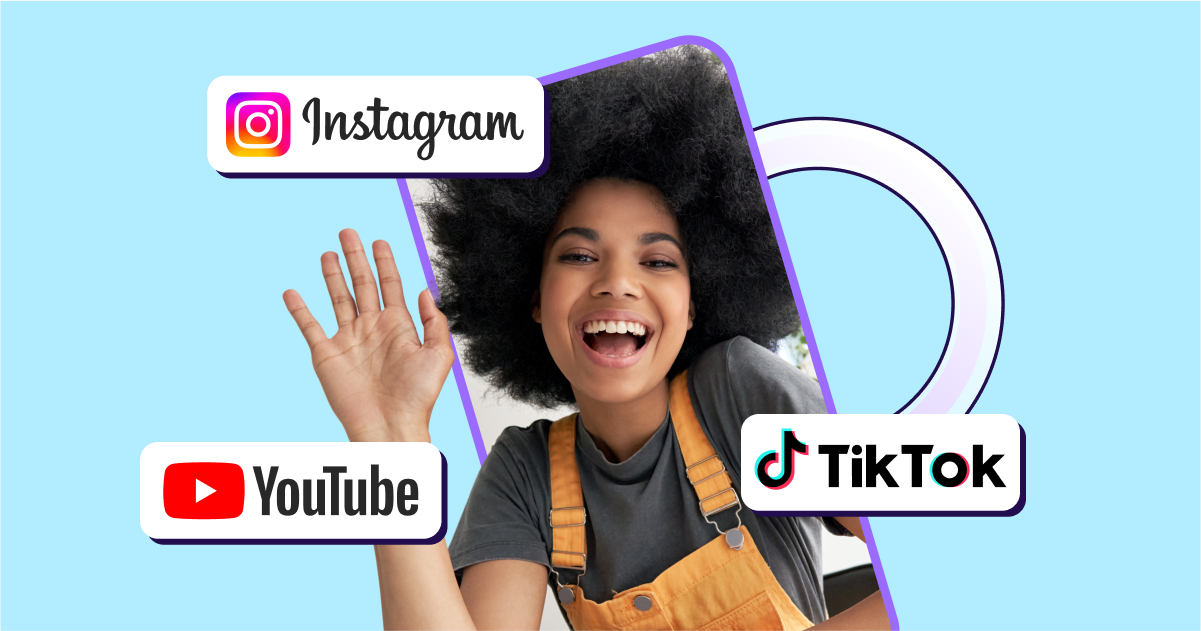
PVOD (Premium video on demand)
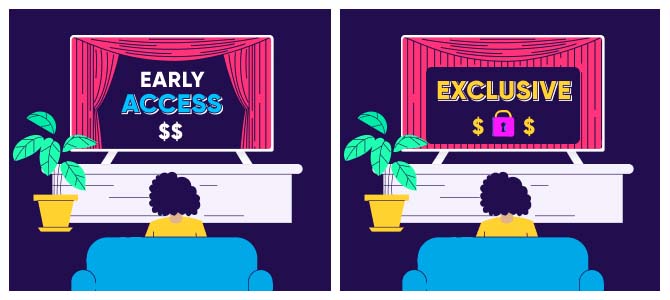
Premium video-on-demand (PVOD) is a revenue model where OTT providers charge viewers a premium price for exclusive early access to video content. It’s similar to traditional video-on-demand (VOD) — the difference is that it offers earlier access for a higher price.
What is premium video on demand (PVOD)?
Premium video-on-demand is a monetization model for visual media distribution in which an OTT provider offers first access to video content at a higher price.
It gives users the option of paying more to access new video titles sooner. Or, if they wait, they can access the content later when it’s more widely available for a lower price.
For example, when Disney+ released Mulan, it used a PVOD strategy. For the first three months after the release, Disney+ made the film available only to their premium access subscribers for an extra $30. After that three-month window, the film became available to subscribers at no additional cost.
PVOD vs. VOD
PVOD is really just an extension of the traditional video-on-demand business model.
In traditional video-on-demand, users pay to access video content. Providers may let viewers subscribe to their service to enjoy all available titles in their library, purchase the content to watch indefinitely, rent the content for a specific period, or pay for each title access.
PVOD uses that same model. What distinguishes it from VOD is simply the timing — PVOD allows viewers advanced access to a specific title or content in exchange for a higher fee.
In other words, with premium VOD, you’re not just selling the piece of video content. You’re also selling exclusivity. Your consumers are paying a premium to watch the content before the general public.
PVOD vs. SVOD vs. TVOD
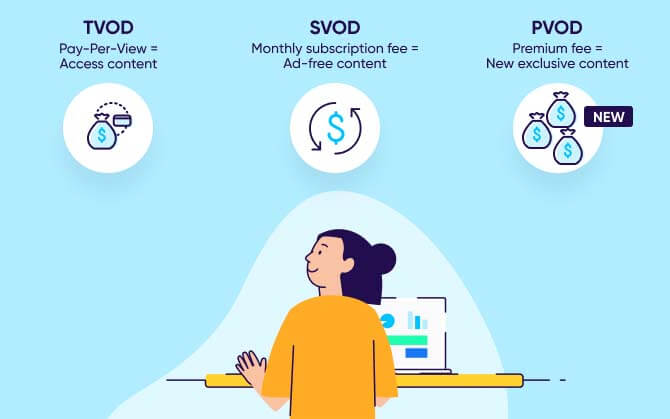
You can also distinguish PVOD from two other monetization models: subscription video-on-demand (SVOD) and transactional video-on-demand (TVOD).
With SVOD, users subscribe to a video content service like Netflix, HBO Max, or Disney+, where subscribers can access all the titles the platform offers.
Subscription-based providers can then choose to add on PVOD for highly anticipated films to generate extra revenue. SVOD and PVOD are therefore not mutually exclusive models — you can add a PVOD model to an SVOD model.
TVOD is a model where users pay to access each title separately on a pay-per-view basis — think Apple’s iTunes and Amazon’s video store. Users can typically rent or buy, and each option has a different name:
- Electronic sell-through (EST) is when an OTT provider sells viewers a title. In this version, the viewer maintains permanent access to the piece of video content.
- Download to rent (DTR) is when viewers pay for temporary access to a piece of video content, allowing them to watch the content as much as they like during the rental period.
PVOD is very similar to TVOD in that users have access on a pay-per-view basis. The difference is that PVOD charges a higher price and offers earlier access.
Premium VOD revenue
Is PVOD a good business model?
It certainly can be. While the exact figures for PVOD revenue from major studios aren’t publicly available, Michael Bonner, president of Comcast-owned Universal Home Entertainment, publicly estimated that there’s over $1 billion of annual consumer spending tied to PVOD.
Another analysis suggests that the number was closer to $525 million for 2021, although that doesn’t include revenue from Disney+’s Premier Access.
Revenue between $525 million and $1 billion is impressive, even if it makes up only a sliver of the $32.3 billion home entertainment spending in 2021. It suggests that while PVOD is not a primary income source, it could be a fairly significant opportunity to boost revenue for streaming services and connected TV companies.
Premium VOD trends
As the revenue estimates suggest, PVOD has become quite popular among consumers in the United States. According to an October 2021 survey, 56% of U.S. customers prefer watching new movies via PVOD rather than in a movie theater.
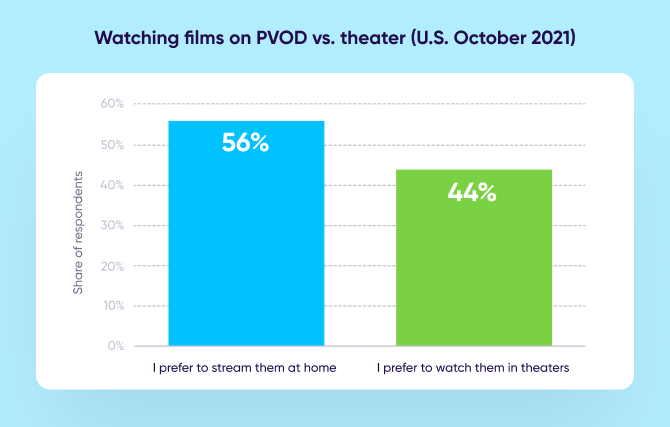
A separate survey found that 33% of U.S. customers had paid to watch a film via PVOD — up from just 19% the year before.
Popularity skyrocketed during the pandemic
PVOD became especially popular during the pandemic when consumers couldn’t watch new releases in theaters, incentivizing media companies to release some films simultaneously in theaters and on PVOD.
Two excellent examples of this strategy are the comedy Bill and Ted Face the Music and the animated movie Trolls World Tour. Some studios released films like Mulan using an exclusively PVOD strategy, skipping the theaters entirely.
With theaters back open, it’s much more common for studios to first release films only in theaters for a few months, and then follow that with an exclusive window of availability on PVOD before releasing the movies to the wide public.
Because PVOD became popular only in the unusual context of the pandemic, it’s unclear whether its popularity will continue to grow at the expense of the big screen. Industry experts, however, are placing their bets on the continuous expansion of OTT content, given its high availability and ease of use.
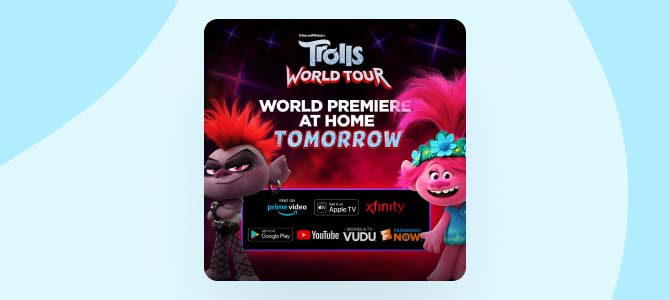
PVOD is unlikely to disappear
Evidence suggests PVOD is here to stay.
Users have continued to purchase PVOD videos even after theaters reopened, with a July 2022 survey suggesting that 14% of all adults made a PVOD transaction that month.
Perhaps more telling is PVOD’s popularity among younger generations. Almost 25% of Millennials and 17% of Gen-Z adults reported making a PVOD purchase in the last month. The younger generations’ demand for PVOD suggests that this model will likely remain a viable revenue stream for years to come.
Premium video on demand advantages and disadvantages
As a monetization model, PVOD has shown that it can successfully generate revenue, given the fact that viewers appear willing to pay more for early access to their favorite video content.
PVOD can bring in new streaming subscribers
PVOD is a great user acquisition channel.
For example, HBO Max has reported a significant increase in new customers joining their subscription service to access their PVOD products. As WarnerMedia’s President of Content, Jim Wuthrich, has said “It’s really quite encouraging. We saw a lot of new customers coming in through premium (VOD), and then they stick around.”
PVOD may create legal challenges
PVOD has created some legal challenges for production studios.
In one high-profile example, Disney+ released Black Widow in theaters in 2021, where it generated $80 million at the U.S. box office and $78 million internationally. During the same time, Disney also released the film in PVOD form to subscribers, generating another $60 million.
Scarlett Johansson, who starred in the film, filed a lawsuit against Disney+, alleging that it breached her contract with the simultaneous PVOD release. As a result, she lost benefits from a profit-sharing agreement.

Similarly, WarnerMedia has reportedly paid $200 million in talent bonuses to actors, producers, and directors after releasing its 2021 film slate on HBO Max and potentially reducing theater profit sales.
PVOD may cannibalize other forms of revenue
At the heart of these legal challenges lies the issue of simultaneously releasing films in theaters and via PVOD. This dual release resulted in decreased theater sales, so instead of creating additional revenue, it may have simply stolen it from cinemas.
While PVOD has demonstrated that it can generate significant revenue for studios, it’s not yet clear whether that revenue adds to or replaces theater revenue.
Is PVOD the right model for you?
It depends on your product suite and audience.
PVOD works by offering customers exclusive early access to your video content. Films like Black Widow and Mulan generated significant revenue using a PVOD model because viewers wanted to see them as soon as possible. Exclusive early access was desirable.
That said, this model may not work well for content that doesn’t create high and immediate demand.
Of course, you might not know whether PVOD will work for you until you try it. This is what the big video studios have been doing for the past few years — they’re testing different models for releasing videos and seeing what works best for them.
Engaging in a similar testing strategy could be one way to find out if PVOD could work in your context.
Key takeaways
- Premium video-on-demand is a revenue model where you offer exclusive early access to video content at a premium price.
- In this model, viewers aren’t just paying for the video content — they’re also paying for the ability to watch the content before others have access to it.
- PVOD grew significantly while people couldn’t go to theaters. It has continued its popularity since, generating between $500 million and $1 billion in 2021.
- It’s unclear whether PVOD will continue to grow outside of the context of recent theater lockdowns, but it will almost certainly continue to be a significant source of streaming revenue.
- Whether PVOD can be effective for your business depends on whether your product could be more valuable to your customers if they have early access to it.



